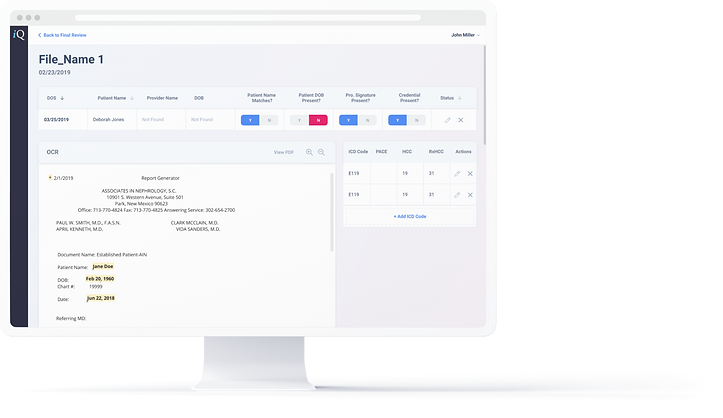

iQuartic is a health software company that helps risk-adjustment experts determine pricing for insurance policies based on individual patient data. Neuron worked with iQuartic to design and develop a React web application that modernized their existing internal workflow management and review tools.
Designing an improved workflow management system
iQuartic
WEB APP UX/UI DESIGN:

Collaborating with subject matter experts
We worked closely with the Director of Medical Coding to understand the ins and outs of iQuartic’s risk adjustment processes. Our Discovery work and partnership approach helped us to understand their existing processes, pain points, and objectives.
By leveraging their knowledge and expertise, we were able to get up to speed on the product quickly, while improving the client’s understanding of the solution we implemented. Together we covered everything from technical debt to customer feedback.
Designing for intended workflows
By mapping all the possible user journeys based on their objectives, we were better equipped to create new workflows and optimize existing processes for things like task processing.
Breaking their existing workflow into steps and assessing the word documents and spreadsheets they used for every assessment, helped our designers identify moments of truth and produced detailed product requirements.

Workflow Design
Modernizing processes
After establishing an understanding of the existing manual code capture process, we were able to design a solution that captured medical records electronically.
Following doctors visits, the patient file is converted to a PDF using optical character recognition (OCR). Once this file has been converted it can be scanned with natural language processing (NLP), which then expedites the process of extrapolating relevant conditions for the insurance carrier.
Review Tool - Before

Review Tool - After Redesign

By leveraging optical character recognition and natural language processing, medical records can be parsed for International Classification of Diseases (ICD) codes. These codes, which are maintained by the World Health Organization, classify morbidity data and are used globally as a diagnostic tool for epidemiology and health management.
Making interface improvements
We rewrote the frontend from scratch, using material design best practices and focusing the overall workflow, thus bringing the interface up to the level of contemporary enterprise products. These changes also made it easier for assessors to read and interpret data, input tags, and navigate the product.


By leveraging optical character recognition and natural language processing, medical records can be parsed for International Classification of Diseases (ICD) codes. These codes, which are maintained by the World Health Organization, classify morbidity data and are used globally as a diagnostic tool for epidemiology and health management.

The global data dashboard helps administrators review and analyze company-wide statistics daily, monthly, quarterly, and annually. The dashboard helps empowers teams to track their most important KPIs: velocity and throughput, while also comparing historical data for these key metrics.

Producing a detailed design system
We produced a detailed component library and design system to make future product improvements more efficient. iQuartic’s internal team is now empowered to maintain the consistency of their user experience over time.
Building out a well defined design system in Figma and then isolating React components using Storybook leads to a consistency of look and feel. Other benefits include less time conducting UI quality assurance.
Conclusion
By redesigning their workflow to reflect their ideal process and leveraging technologies like OCR and NLP, iQuartic assessors were able to increase their capacity significantly.
Their new solution is not only faster to use, it is easy to learn.

